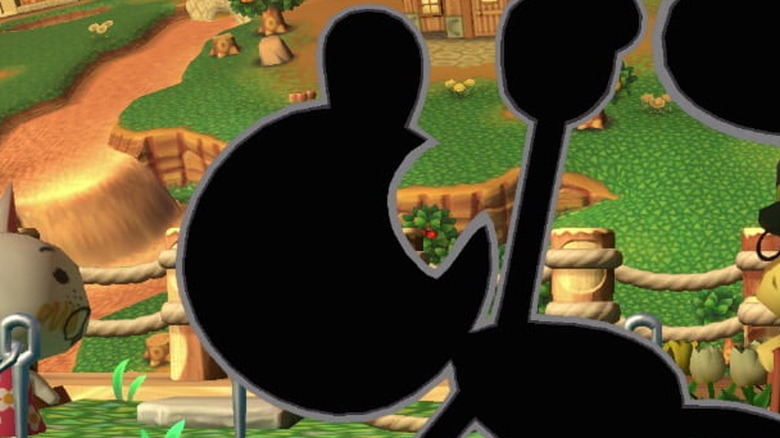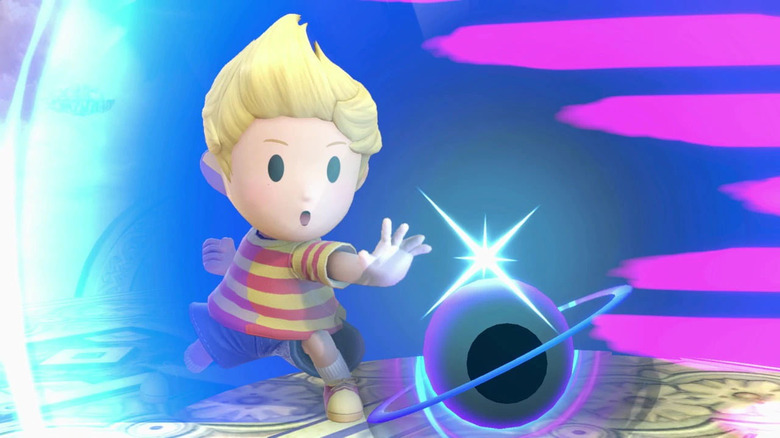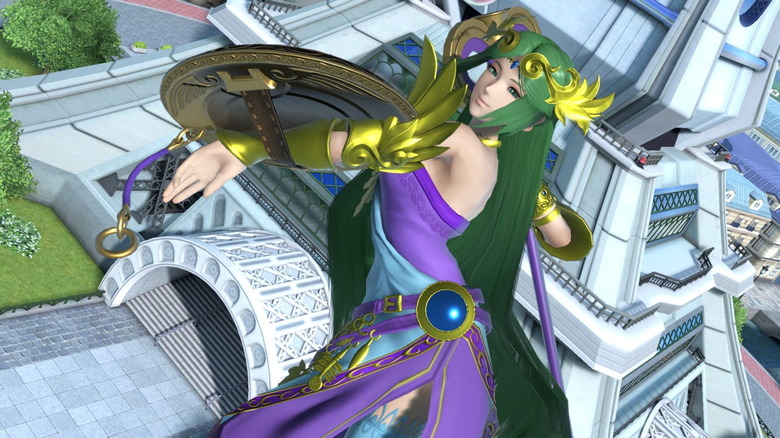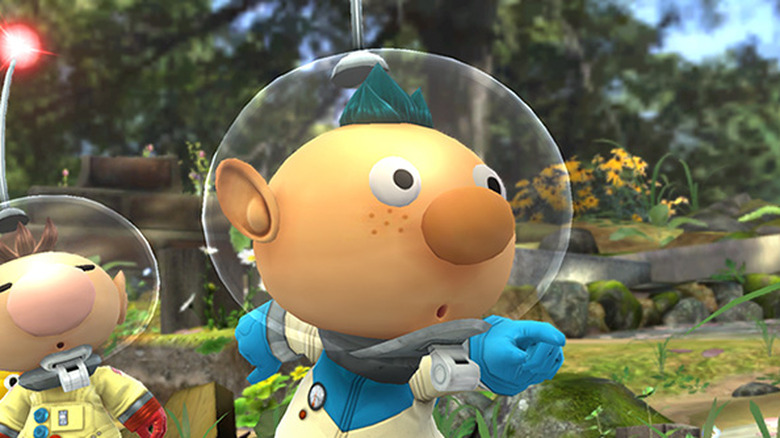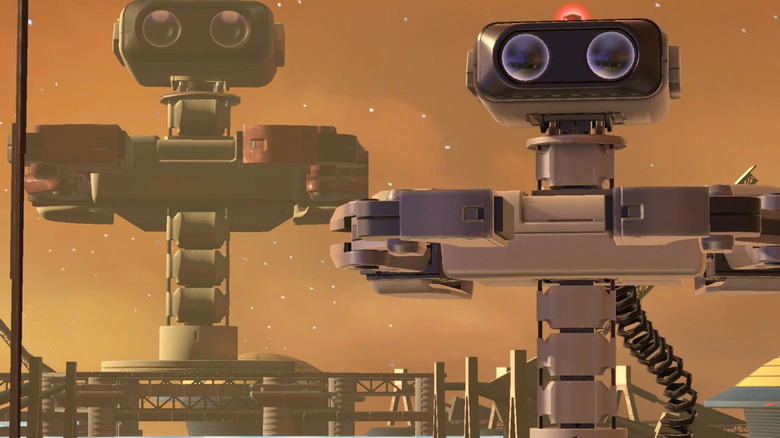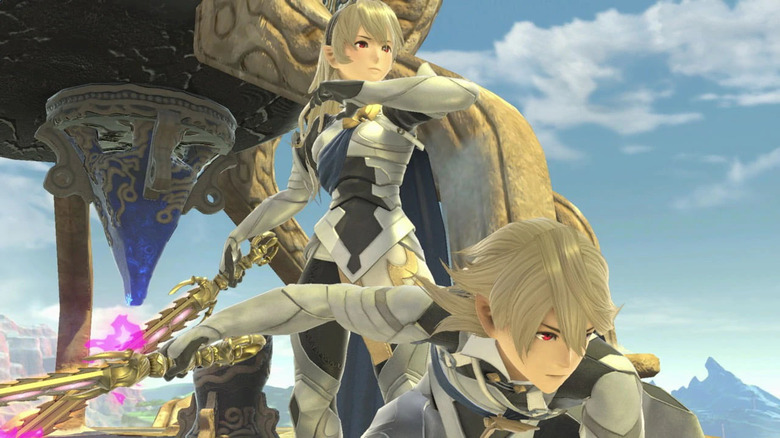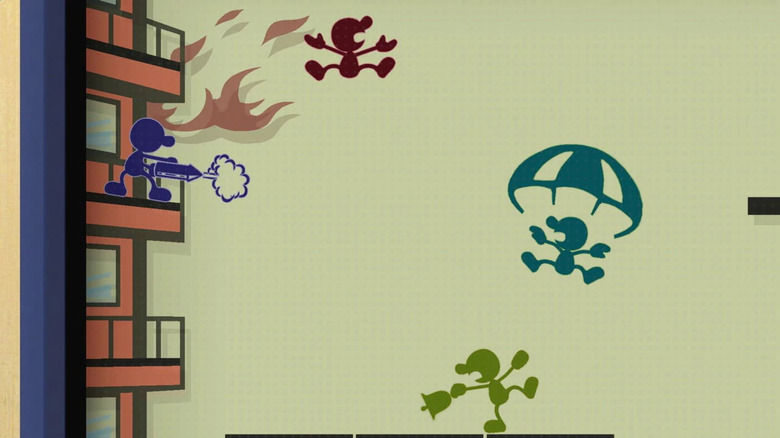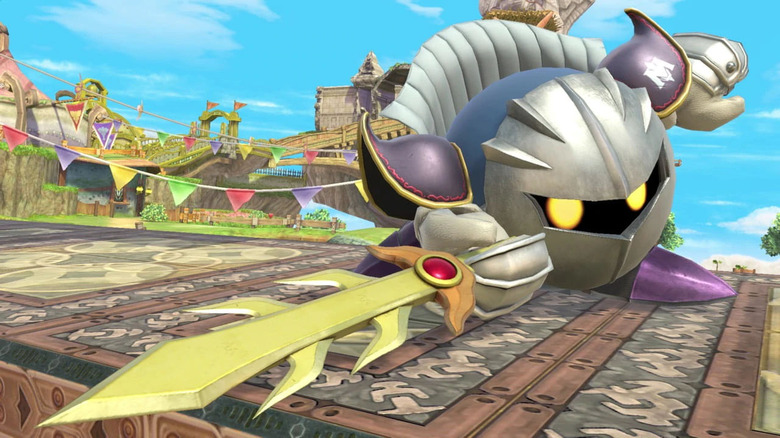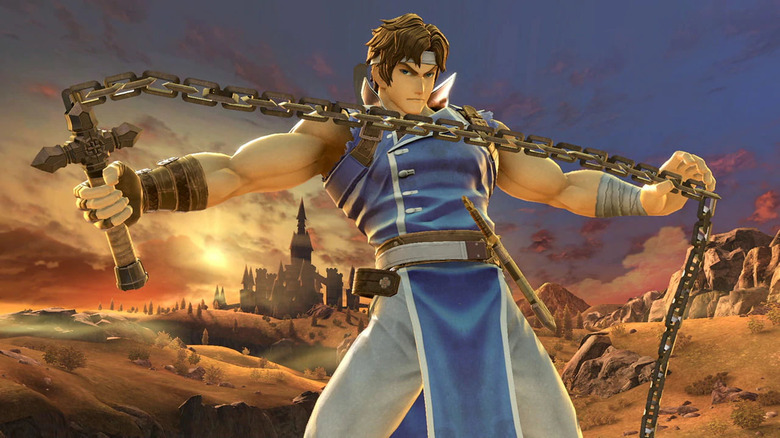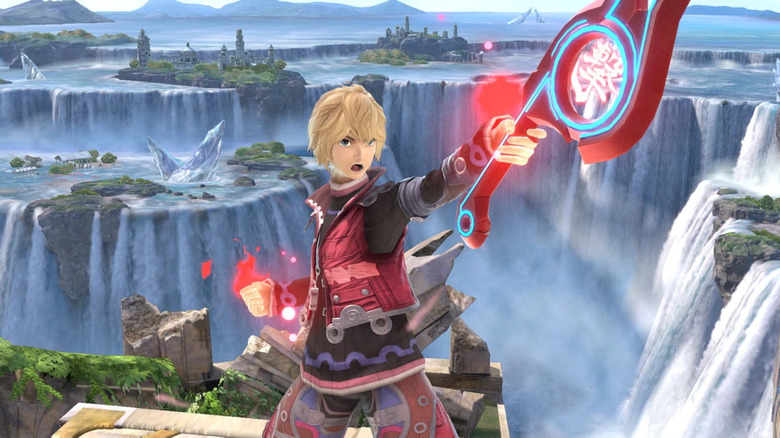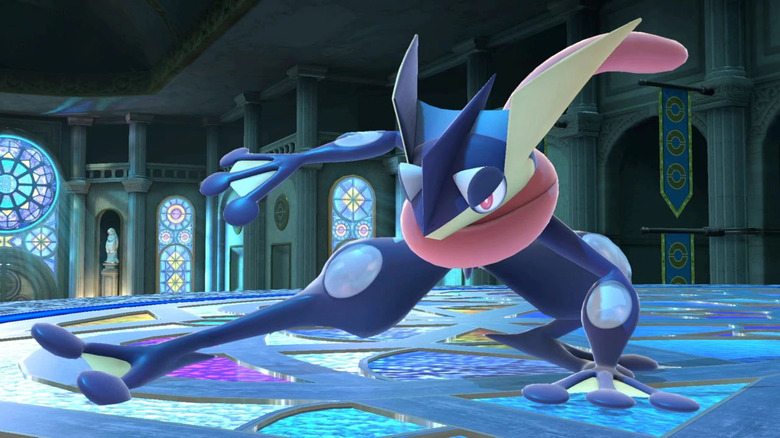Obscure Characters In Super Smash Bros. Ultimate
At its core, Super Smash Bros. might be a fighting game, but for the past 20 years the series has doubled as a heartfelt tribute to everything Nintendo — and Super Smash Bros. Ultimate looks like it'll be the biggest and best lovefest yet. With a roster comprised of 67 different characters (not counting so-called "echo fighters") that includes every single man, woman, and beast that's appeared in a past Smash title, Super Smash Bros. Ultimate is packed full of fan service. Mario, Link, Samus, Pikachu, Pac-Man, Ryu, Cloud, Solid Snake, and the others: if it's a major character, it's here — except for poor Waluigi, of course.
Heck, even if your favorite character isn't a major headliner, he or she might still make a Super Smash Bros. Ultimate appearance. Smash Bros. doesn't just honor Nintendo's top stars. It celebrates all of Nintendo's history, no matter how obscure. That leads to some fun surprises for fans, but it also means that you might run into a character that you're not familiar with. Don't worry. Nintendo's stable goes much deeper than the regular headliners, and the following characters are all worth looking into. Who knows? With a little bit of luck, you might even discover a brand new favorite.
A face that only a Mother (fan) could love
Experienced Smash players will recognize Lucas, the tow-headed kid with psychic powers, from 2008's Super Smash Bros. Brawl. If you're hoping to dive into Lucas' origin story, however, you're out of luck — if you live in the United States, that is. The Mother series, which American fans know better as EarthBound, never officially came out in America.
That's too bad, because by all indications, Mother 3 is the series' best. Like the Super NES' EarthBound (or, as its called in Japan, Mother 2), Mother 3 is a quirky Japanese role-playing game that bucks convention at every turn. The game is split into eight chapters, and features a rotating cast of protagonists. But like Ness before him, Lucas is arguably Mother 3's main character.
Unfortunately, EarthBound flopped in America, and Mother 3 came out right at the end of the Game Boy Advance's lifespan. For Nintendo, bringing Mother 3 overseas simply wasn't worth it. That didn't stop some die-hard fans from localizing the game on their own, though. In fact, the fan community devoted about $30,000 worth of labor to translate Mother 3's 1,000-page script into English. It's quite a feat, and if you want to see where Lucas came from, and while we don't condone piracy, it's absolutely worth checking out for yourself if you're so inclined.
When someone asks you if you're a goddess, you say yes!
Over the past 30-plus years, there have only been three games in Nintendo's Kid Icarus series — the NES original, a Game Boy sequel that launched five years later, and the 3DS' Kid Icarus: Uprising — but that hasn't stopped the series' cherubic hero, Pit, from becoming a second-tier Nintendo icon. Palutena, Kid Icarus' damsel in distress, isn't quite as well known, although she's got a slightly better reputation in Japan: overseas, Kid Icarus is called Myth of Light: The Mirror of Palutena.
According to Kid Icarus' manual, Palutena ruled over Angel Land with a dark goddess named Medusa who ultimately turned on Palutena and locked her up in the Palace in the Sky. Naturally, it's Pit's job to save her. Palutena reaches out to Pit again in Kid Icarus: Of Myths and Monsters when she needs help staving off an incoming invasion, and plays a more active role in Kid Icarus: Uprising, during which she serves as an advisor, saves Pit from a near-death experience, and fights him as one of the game's big bosses.
Just because Palutena occasionally needs a hand doesn't mean that she's a pushover, though. She's playful and funny and doesn't mind giving Pit a hard time. She's also very, very powerful: trust us, any lady that has a move called the "Sacred Goddess Clobberlaser" is someone that you don't want to mess with.
Everyone's favorite Pikmin pal ... no, sorry, the other one
You'd be forgiven for mistaking Alph, one of Pikmin 3's trio of alien heroes, for Captain Olimar, the Pikmin franchise's main protagonist. Both characters toddle around in spacesuits, both come from distant planets and both have a very close relationship with PNF-404's native wildlife, the titular Pikmin.
They're not the same character, though. For one, Alph hails from the planet Koppai, while Olimar resides on Hocotate. Olimar is the captain of his own ship, the SS Dolphin, while Alph is the engineer on a three-man ship called the SS Drake, which Alph's grandfather designed. Olimar discovered PNF-404 after a crash landing, and later returns to loot the planet of its treasure. Alph, meanwhile, has a more altruistic reason for his voyage: Koppai is running out of food, and Alph and his crewmates must gather fruit and seeds from PNF-404 if their species has any hope of surviving.
Alph also serves as the SS Drake's default hero. In Pikmin 3, it's Alph who discovers that the Drake's crew needs to find a "cosmic drive key" to return home, and he's part of the crew who ends up rescuing Olimar, making sure that both are around to appear in Super Smash Bros. Ultimate. Captain Olimar might've taken back the starring duties for the next Pikmin game, Hey! Pikmin, but Alph has more than earned his spot on the Smash Bros. roster. Take a bow, little guy. You deserve it.
He's a robot, he's operating, and he's your buddy
In the early '80s, the American video game industry was in trouble, and retailers weren't exactly eager to stock up on game consoles. After all, they'd just been burnt when Atari, the leading console manufacturer, collapsed under the one-two punch of overproduced titles and insider trading charges, and it didn't look like other companies were going to fare much better. That left the Japanese company Nintendo in a tricky position. Nintendo wanted to sell its newest device, the Nintendo Entertainment System, in the States, but it wasn't sure how to convince stores to carry it.
Nintendo's solution? Sell the NES as a toy, not a gaming machine. That's how we ended up with the Robotic Operating Buddy, or R.O.B., one of the earliest and strangest Nintendo peripherals ever made. See, R.O.B. actually came packed in with early editions of the Nintendo Entertainment System, and Nintendo's marketing emphasized the robot add-on (and the included light gun) more than the console itself.
It sounds silly, but it did the job. While R.O.B. only worked with two terrible games, Gyromite and Stack-Up, and didn't really do anything, the little robot was good enough to get the NES onto store shelves, where it quickly proved its worth as a traditional game console. After a year or so, R.O.B. disappeared and Nintendo quickly rebranded itself as a traditional video game company. Still, R.O.B.'s legacy lives on.
A whole kingdom's worth of confusion
Most Nintendo franchises have a relatively stable cast of characters. Not Fire Emblem. As an ongoing series of tactical RPGs that dabble in Game of Thrones-like fantasy politics, every Fire Emblem game has a cast of characters that feels like it's hundreds of names long. Take Corrin, for example, who joined the Super Smash Bros. roster as DLC in 2016. Corrin is the lead character in Fire Emblem: Fates, but you may not recognize the name — in fact, depending on your choices when you start Fates, you may not recognize him (or her) at all. As Fire Emblem: Fates' "avatar," or player character, you can decide whether or not Corrin is male or female, change how he or she looks, and give Corrin a completely different name.
No matter what you choose, Corrin's backstory stays the same. She's always a member of the Hoshidan royal family by birth and the Nohr royal family via upbringing, and she's always able to transform into a dragon. Pretty much everything else, however, relies on the players' choices. It's a great way to make Fire Emblem: Fates more immersive. It's also a fantastic way to confuse Smash Bros. players. One tenth of Super Smash Bros. Ultimate's roster comes from Fire Emblem, and if you're already struggling to tell your Ikes from your Marths from your Chroms, Corrin isn't going to make things any easier.
A blast from Nintendo's past
Since 1989, Nintendo has had a stranglehold on the portable gaming market, but the company's forays into hand-held video games didn't start with the industry-changing Game Boy. In fact, Nintendo's been making portable consoles since 1980, a year before Donkey Kong introduced players around the world to Mario and a full half-decade before the NES hit American shores.
As the story goes, Nintendo's Gunpei Yokoi watched a fellow train commuter play with a digital calculator and quickly came up with the idea for Game & Watch, a series of small LCD-based portable games with pre-printed background and a D-pad instead of a joystick, a small but important innovation that'd change gaming forever. The first Game & Watch titles were simple — in the first, Ball, you're basically just juggling — but they were also pretty fun.
Game & Watch premiered before Nintendo had a mascot, however, and while Mario ended up appearing in a few different Game & Watch titles in later years, many starred a simple black-and-white human silhouette. For Super Smash Bros. Melee, Nintendo renamed the character Mr. Game & Watch, streamlined his design, and gave him moves from various Game & Watch titles. Competitively, Mr. Game & Watch may not be the most formidable fighter, but if you're an old-school Nintendo fan — we're talking very old-school — he's still an absolute blast to play.
When people talked about the Smash Bros meta, this isn't quite what they had in mind
It only takes a quick glance to confirm that Meta Knight is part of the Kirby franchise. Give or take a few fingers, they're basically the same shape, and on the rare occasions where Meta Knight shows his face, the two look awfully similar. But Meta Knight isn't Kirby's arch-nemesis — that'd be fellow Super Smash Bros. Ultimate fighter King Dedede — and throughout the little pink puffball's series, he serves as both a hero and a villain. Who is Meta Knight, and what secrets lurk behind his stylish silver mask?
We're still not sure. Meta Knight made his first appearance in 1993's Kirby's Adventure, where he played the part of a minor villain under King Dedede's command. In Kirby's Super Star, Meta Knight is the main antagonist of the aptly named Revenge of Meta Knight. But in Kirby & the Amazing Mirror, Kirby faces off against "Dark Meta Knight" — implying that the real Meta Knight isn't dark at all — and is ultimately rescued when Meta Knight intervenes at the last minute. In Kirby: Squeak Squad, Meta Knight serves as a boss again, but later plot developments reveal that he was trying to help keep Dream Land safe. He just had to fight Kirby to do it.
Occasionally, he even serves as a bonus character that you can control yourself. Kirby fans still don't know where Meta Knight's true loyalties lie, but at least he looks cool.
The forgotten Belmont cousin
Poor Richter. He played a major role in Castlevania: Symphony of the Night, the game that became famous for putting the "vania" in Metroidvania games, and officially became the last member of the Belmont clan to wield the Vampire Killer whip for hundreds of years. And yet, Richter still isn't nearly as famous as Simon, Castlevania's original hero, or Alucard, Dracula's backwards-spelled son.
It's easy to see why. Unlike Simon, who helped birth the Castlevania franchise, Richter's first leading role came in Castlevania: Rondo of Blood, a Japanese-only title that launched on the PC Engine (the console known in America as the TurboGrafx-16). The game was remade a few times, including a Super NES port that arrived in 1995, but it quickly fell under Symphony of the Night's shadow and has yet to re-emerge.
From there, Richter popped up a handful of times, most notably as a mind-controlled boss and secret player character in Symphony of the Night. Richter also helps train the player as a "living memory" in Castlevania: Portrait of Ruin, and he joined the roster in the co-op Castlevania mashup Castlevania: Harmony of Despair, assuming you paid for him — in that game, he's merely as a piece of DLC. Richter's only other big contribution to Castlevania's ongoing storyline comes in Nocturne of Recollection, a Japanese radio drama. Even in Super Smash Bros. Ultimate, Richter doesn't really stand alone: he's a Simon Belmont "echo fighter," meaning that he looks a little different, but can only execute his great-grandfather's moves.
Don't Shulk — do something about it!
If you live in America and know who Shulk is, consider yourself lucky: his game of origin, Xenoblade Chronicles, almost didn't make it to this country at all. Originally revealed in 2009 as Monado: The Beginning of the World, Xenoblade Chronicles came out in Japan in 2010 to rave reviews. The game hit Europe about a year later, bringing a full-on English translation with it. And yet, for some reason, Nintendo of America didn't want to release the game stateside. We're still not sure why.
JRPG fans weren't having any of it, however, and a group quickly came together to help bring Xenoblade Chronicles to the USA. The confederacy dubbed itself Project Rainfall and quickly started bombarding Nintendo with letters encouraging the company to release Xenoblade, among others, to the United States. It worked. Even though the Wii was on the way out by 2012, Nintendo decided to release all three games anyway. Xenoblade Chronicles went on to sell more copies in the West than it did in Japan, and sparked both a 3DS remake and a fully-fledged sequel.
In other words, thank the fans when you boot up Super Smash Bros. Ultimate and see Shulk, Xenoblade Chronicles' methodical and devoted protagonist, waiting for you on the roster. Without them, those of us in America wouldn't know anything about Shulk; his reality-shifting energy blade, the Monado; his home settlement, Colony 9; or his delightfully convoluted backstory — and we'd be much poorer for it.
Well, that's one way to keep warm
Honestly, there's probably no such thing as a truly obscure Pokémon character. Since the pocket monsters arrived in the mid-'90s, Nintendo has sold over 300 million Pokémon games, a number that's good enough to make Pokémon the second-best-selling video game series of all time, behind only Mario. That means that lots of people have spent lots of time with the franchise, and there probably aren't too many members of Pokémon's roster that remain truly mysterious.
Still, Greninja didn't make his way onto the Pokedex until relatively recently — he didn't debut until Pokémon X and Y came out in 2013 — so if you're a lapsed Pokémon trainer, you might not know what's up. Here's the scoop: Greninja is a water/dark-type Pokémon who's native to the Kalos region, and who represents the final evolutionary form of the frog-like Froakie, one of Pokémon X and Y's starters. As per its name, Greninja has a ninja's grace and speed, but he's mostly known for his long tongue, which he wears around his neck like a scarf.
In addition, Greninjas can bond with select trainers in order to earn a massive power boost, although that's pretty rare. In fact, according to Pokémon lore, it's only happened twice (naturally, Pokémon's bumbling hero, Ash, was one of the lucky few).

